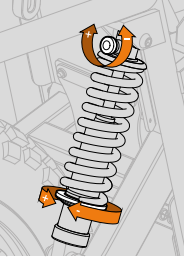The front and rear suspensions have adjustable rebound controls that change the rate the suspension re-extends after an impact. They also feature spring preload adjustment that are helpful for setting the loaded ride height of the vehicle and help determine the suspension’s ability to prevent bottoming out (AKA setting the Sag). These adjustments allow the rider to set the loaded ride height for various use cases and terrains to improve the handling and capability of the vehicle. For more demanding terrain, or higher load carrying capacity, we recommend increasing the preload to prevent harsh bottom out forces.
Front:
Rebound speed is adjusted on the right-hand side of the fork crown. Twist the dial clockwise to slow the rebound; counter-clockwise to speed it up. On the left side of the fork, the spring preload is adjusted. Twist the dial clockwise to lessen the spring force; counterclockwise will increase the spring force.

Rear:
Rebound control can be adjusted using the red dial at the top of the spring. Twist the dial counter-clockwise to slow the rebound; clockwise speeds it up (this is opposite to the front fork). To adjust the rear spring preload, wind the disk at the base of the spring clockwise to lessen the spring force; twist counter-clockwise to increase the spring force. The rear suspension preload and rebound controls should be set equally on both sides of the bike.


Suspension Recommendations
| FRONT REBOUND |
FRONT SPRING |
REAR REBOUND |
REAR SPRING |
|
| On-road Rider only (90kg) |
Max fast | Full soft | Max fast | 20mm thread exposed |
| On-road + Load (125kg) |
Max fast | t 1 full turn to hard |
4 clicks towards slow |
20mm thread exposed |
| Off-road Rider only (90 kg) |
Max fast | Full soft | 2 clicks towards slow |
30mm thread exposed |
| Off-road + Load (125kg) |
Max fast | 1 full turn to hard |
6 clicks towards slow |
30mm thread exposed |
Note: if riding on a hard surface while off-road, such as hard, dry ground or tracks, adjust the suspension to on-road settings.
Pre-ride Inspection
You should perform a pre-ride inspection each time you ride to ensure all parts are in full working order. DO NOT operate the bike if it is materially defective in operation, damaged, or missing safety-related equipment. Physically check off each of the following before you ride:
- Lights – Ensure the headlights, rear light, brake light and directional indicators are working.
- Power supply – Ensure there is enough charge to carry out your work or journey. Ensure the battery strap is secured tightly.
- Tyres – Check the condition and pressure of the tyres. Tyres are interchangeable and can be swapped out if required (details in Maintenance& Care).
- Brakes – Check they are operational and check the brake pad wear.
- Bedding-in – Complete the process to bed-in the brakes before your first ride.
- Mirrors – Check they are adjusted for proper viewing and are not obstructed by any load you may be carrying.
- Horn – Check it sounds.
- Loose nuts, bolts, or fixings – Ensure all are done up correctly and are secure.
